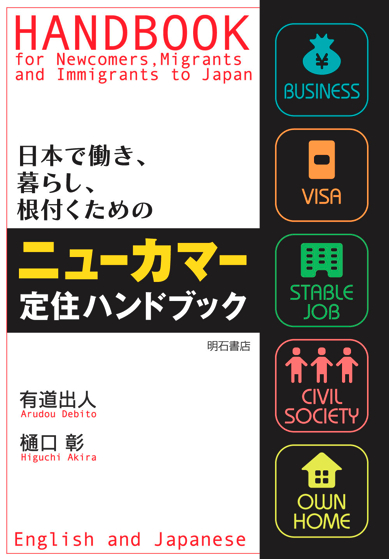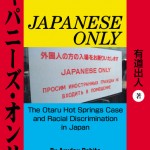mytest






Hi Blog. Mark in Yayoi pointed out a singular thing to me the other night — that the Tokyo Nerima-ku website lists its population and households in various municipal subsections. Then puts at the top that “foreigners are not included”.
Screen capture (click on image to go to website) from:
http://www.city.nerima.tokyo.jp/shiryo/jinko/data/area/200810.html
etc. We already saw in yesterday’s blog entry that NJ workers are not included in official unemployment statistics. Now NJ taxpayers are also not included as part of the “general population”?
So I did a google search using the words “人口 総数には、外国人登録数を含んでいません” and found that other government websites do the same thing! It is, in fact, SOP.
http://www.google.com/search?client=safari&rls=en&q=人口 総数には、外国人登録数を含んでいません。&ie=UTF-8&oe=UTF-8
The Nerima-ku page, BTW, does not even mention anywhere on the page I captured above that foreigners even exist in Nerima-ku — you have to go to a separate page, a separate enclave, for the gaijin.
Pedants (meaning the GOJ) will no doubt claim (as is worded at the top) that “we’re only counting registered residents, and NJ aren’t registered residents, therefore we can’t count them“. But that doesn’t make it a good thing to do, especially when you’re using the context of “人口総数” (total population). What a nasty thing anyway to do to people who pay your taxes and live there! It also becomes a tad harder to complain about “Japanese Only” signs on businesses when even the GOJ also excludes foreigners from official statistics.
And it’s also harder to believe the GOJ’s claim to the UN that it has taken “every conceivable measure to fight against racial discrimination”. How about measures like counting (not to mention officially registering) foreigners as taxpayers and members of the population?
(I bet if any measure actually does get taken in response to this blog entry, the only “conceivable” one to the bureaucrats will be to change the terminology, using the word “juumin” instead of “jinkou sousuu”. Solve the problem by futzing with the rubric, not changing the law. Beyond conception.)
Arudou Debito in Sapporo
==============================
UPDATE: And of course, don’t forget this, from Debito.org too…
Population rises 1st time in 3 years The Yomiuri Shimbun, Aug 1, 2008 http://www.yomiuri.co.jp/dy/national/20080801TDY01306.htm
The nation’s population grew for the first time in three years to 127,066,178 in the year to March 31, up 12,707 from a year earlier, the Internal Affairs and Communications Ministry said Thursday.
The figure was based on resident registrations at municipal government offices and does not include foreign residents…

13 comments on “Govt websites don’t include NJ residents in their tallies of “local population””
My reading of
The government does not track the number of jobless foreigners, but local officials, workers and employment agencies tell of hundreds of workers like Sameshima let go by companies linked to topflight producers – Toyota, Honda, Yamaha.
from yesterday was that foreigners weren’t tracked specifically, not that they weren’t included in the statistics as you wrote today.
Strange that they list like this, as the Bureau of Statistics census information lists the population quite differently, sousuu=nihonjin+gaikokujin. All list, counted and shown separately.
http://www.e-stat.go.jp/SG1/estat/List.do?bid=000001005118&cycode=0
The City of Setagaya (Ku) official Municipal Newsletter print and web edition publishes the population in every issue.
Below from the website:
Number of Households and Population in City of Setagaya (as of September 1, 2008)
Registered Residents 829,914
Male 397,181
Female 432,733
Households 433,125
Registered Foreign Residents 15,576
Male 8,016
Female 7,560
http://www.city.setagaya.tokyo.jp/english/eigo_koho/2008/0810/index.html
They only count ‘humans’, right?
Just kidding.
Shinjuku-ku includes foreigners in its tally of residents (perhaps fittingly, since it has the largest (registered) foreign population of all the 23 wards):
http://www.city.shinjuku.tokyo.jp/division/210101kikaku/tokei/2008/GaikyoH20_01.pdf
Curiously though, it then offers a breakdown of the total into: Men, Women and Gaikokujin. I was not aware that “foreign” constituted a third sex.
The figure I would really like to see is how much of their tax income comes from foreigners – a fairly hefy chunk of my salary disappears each month into the coffers of Shinjuku-ku via juminzei.
The head scratching thing with the Nerima-ku example, is that in January 2005, the foreigners were included, even given their own special row…
http://www.city.nerima.tokyo.jp/shiryo/jinko/data/area/200501.html
Then, one month later, they just disappeared…
http://www.city.nerima.tokyo.jp/shiryo/jinko/data/area/200502.html
— Excellent find, well done. Thanks for tracking this down. This is not due to some “ancient philosophical byproduct of a country with a history of being closed to the outside world” type of excuse. This is a modern phenomenon — where we have to separate the natives from the foreigners for some modern political reason (foreign crime, terrorism, contagious diseases…?)
Debito, a more accurate title for this blog post is – “Nerima only lists foreign registrants in January.” Take a look through all of Nerima’s population listings:
Nerima Population Listings
The number of foreigners registered is listed every year, but in January only. This includes Heisei years 17 through 20. It looks to me they have a different tracking system for foreign residents, and I’m willing to bet that it’s based on taxes filed with the city of Nerima. I can’t speak for their reasons why they do it this way, but they probably do it once a year to exclude non-tax paying, temporary residents.
— Excellent also, Icarus. Thanks! Debito
Icarus has hit the nail on the head. Juuminzei is calculated based on where someone lives in January of any given year. In other words, if you live in Tokyo in January 2009 but move to Yokohama in February, your Juuminzei for all of 2009 will be paid to Tokyo (even though you don’t live there anymore). This is also why it is advisable for those foreigners who are planning to return to their home country during the winter to do so in December. Technically, one would still be liable for Juuminzei even if they moved back to their home country as long as they were in Japan in January. Now sure, they have no way of collecting form overseas, but if you ever wanted to come back to Japan you wouldn’t want to be on a list as a “tax dodge”. I have also heard pro baseball players use this loophole – move into Japan in early spring for camp, move out as soon as the season is over. If they are never living in Japan in January, they never have to pay juuminzei (this part I was able to confirm with a tax lawyer – but I couldn’t tell you how many ball players take advantage of this).
Anyway, for the rest of the year Nerima seems to only be listing “registered households” under the juuminhyou definition. Since foreigners don’t have juuminhyou, they aren’t part of the number counted. And since foreigners are only required to “report in” when they move to a new residence, but not “log out” from their old one, tracking can get problematic (which is why the MOJ and others want to consolidate the system). Japanese don’t have this problem, as in order to legally “move into” a new locale they have to bring a piece of paper showing they “moved out” of the old one. Monthly lists of registered households are therefore easy-peasy.
MARK IN YAYOI ADDS:
Here are the offending population figures (including
Nishi Oizumi-machi, population 13 + N, where N is some undetermined
number of perfectly legal aliens):
http://www.city.nerima.tokyo.jp/shiryo/jinko/data/area/200810.html
Here’s a Wiki entry on Nishi-Oizumi-machi:
http://ja.wikipedia.org/wiki/西大泉町
And here’s a web site from someone who visited:
http://www.geocities.jp/ur_route_neo/nishioizumi.html
Other sections of that ward that seem interesting:
* Kitamachi 4 has a 920-81 male-to-female ratio. Turns out there’s a
military base there. (So SDF personnel count as local residents where
they’re stationed?)
* Hikarigaoka 4 is a park and has no residents at all.
Bunkyo-ku also lists non-citizens separately, without including them
in the districts where they reside (the 外国人登録者数, totaling about 3% of
the ward’s population, are all together at the very bottom):
http://www.city.bunkyo.lg.jp/sosiki_busyo_kumin_jigyou_toukei_zinko_tyotyo2010.html
Hard to say if they’re just being lazy and can’t be bothered to count
people not covered by the juminhyo system, or if they actually don’t
want to count them.
ENDS
Hi folks; I’m the one who mentioned this to Debito originally.
The thing I was taking issue with was not that the municipalities weren’t counting foreigners — they clearly are, even if they’re unfortunately on separate lines — but that foreigners are not included in the districts or sub-sections of the towns in which they live. It’s as if in each municipality there are a number of districts, plus one Virtual Dejima on which all non-citizens invisibly reside!
Consider the tiny and fascinating district of Nishi-Oizumi-machi in Nerima is an East Berlin- or Lesotho-like enclave, completely surrounded by Saitama:
http://map.yahoo.co.jp/pl?type=scroll&lat=35.75945483&lon=139.57070215&sc=3&mode=map&pointer=on
Being in such an unusual position, it escaped the wanton destruction and amalgamation of place names that swept through Japan’s larger cities in the 1970s, as venerable old district names were replaced by dull ones and simple numbers like “137” were dumped in favor of bureaucratic monstrosities like “2-53-19”.
(My district, Yayoi, had its name spared when a group of writers and activists prevented it from being amalgamated with nearby Nezu. They couldn’t stop it being split into two cho, but at least they saved the name.)
Now where this becomes interesting with regards to foreign residents is that some districts, like the Nishi-Oizumi-machi enclave, are tiny and only contain a few houses. Since Nerima-ku doesn’t count non-citizens as part of the districts in which they live, the “population” figures can end up being totally meaningless.
If a Japanese family of four were to sell their home and a foreign family were to move in, the “population” would drop from 13 to 8, with the real population in fact being 63% higher that what goes on the books. Ridiculous!
I’m not ready to castigate the municipalities for making separate columns for non-citizens — perhaps seats in city assemblies are in proportion to the number of voters or something similar and so they can’t lump everyone together — but ignoring non-citizens altogether doesn’t seem to make sense.
Now I’m looking over Giant Panda’s link, and while Shinjuku does include its roughly-10%-foreign population in the total, all the detailed breakdowns such as those by age and district all use only Japanese citizens as the base. I find this egregious — I’m proud enough of my district (having specifically selected this area to move to six years ago) to include it in my handle name on this site, and would be welcomed into the chounaikai were I to join, but the larger municipality of Bunkyo-ku ignores my existence.
Let me assure you that despite what the Bunkyo-ku page tells you, the combined population of Yayoi 1 and 2 is not 1908, but more than 1909 — possibly much more. The bureaucrats should have a little more pride in statistical accuracy, and should stop subtracting out non-citizens from their districts.
>QUOTE<They only count ‘humans’, right?
No they only count taxpayers, I mean they find us on their computers every year when it comes to pay taxes (especialy local one:)
“And since foreigners are only required to “report in” when they move to a new residence, but not “log out” from their old one, tracking can get problematic.”
It shouldn’t be. When you move from City A to City B, you only tell City B, but City B then has to have your registration record transferred from City A. Likewise, when you leave Japan without a re-entry permit, Immigration notifies the city that you have left so the registration record can be sent to the Justice Ministry’s archive.
So each city should be able to tell how many foreigners are registered residents at any given time, with only slight inflation for people who have left within the last few weeks.
OK, having read the original item three times and all the comments twice, I think I’m ready to pass judgement. 🙂
There’s really no way around the fact that 人口 means “humans present”, and if they actually want to say 日本国籍を持つ人口, they need to say that.
Debito and others are also quite correct that the criteria for a 住民 cannot legitimately exclude *anyone* who is expected to pay 住民税. No excuses about traditions or voting or phantom terrorism or anything else can get around that. If they want to exclude non-nationals from being “residents”, they can’t charge them “resident tax”.
Loose terminology that facilitates exclusion, wishing-away, and outright falsehood needs to be challenged. The UN should not allow member states to translate treaties (for example) in invidious ways, either (“kokumin”, meaning nationals only, for “people”, meaning anyone under the power of a member state government).
And of course, don’t forget this, from Debito.org too…
Population rises 1st time in 3 years
The Yomiuri Shimbun, Aug 1, 2008
http://www.yomiuri.co.jp/dy/national/20080801TDY01306.htm
The nation’s population grew for the first time in three years to 127,066,178 in the year to March 31, up 12,707 from a year earlier, the Internal Affairs and Communications Ministry said Thursday.
The figure was based on resident registrations at municipal government offices and does not include foreign residents…
http://www.debito.org/?p=1860